Earthquake Resistance Analysis of Indian Houses using SpaceGass
VerifiedAdded on 2022/10/19
|25
|3429
|147
Report
AI Summary
This report presents a structural analysis of the earthquake resistance of Tharthara, Assam, and Adobe houses, focusing on their behavior under seismic loads. The study utilizes SpaceGass software to model and analyze the structural performance of these house types, considering factors such as material properties, building design, and geographical location in India and Sri Lanka. The report begins with an introduction to earthquake-resistant design principles and a description of the different house types. It then delves into the SpaceGass analysis, including the application of appropriate loading conditions (dead, live, wind, and earthquake loads) and the interpretation of results such as deflections, bending moments, and shear forces. The analysis includes linear static and dynamic response analysis. The report provides a comparative analysis of the three house types, highlighting their strengths and weaknesses in resisting seismic forces. The findings are presented through diagrams and tables, offering a comprehensive overview of the structural behavior. The conclusion summarizes the key findings and offers recommendations for improving the earthquake resistance of these building types. The report also includes references to relevant building codes and research papers.
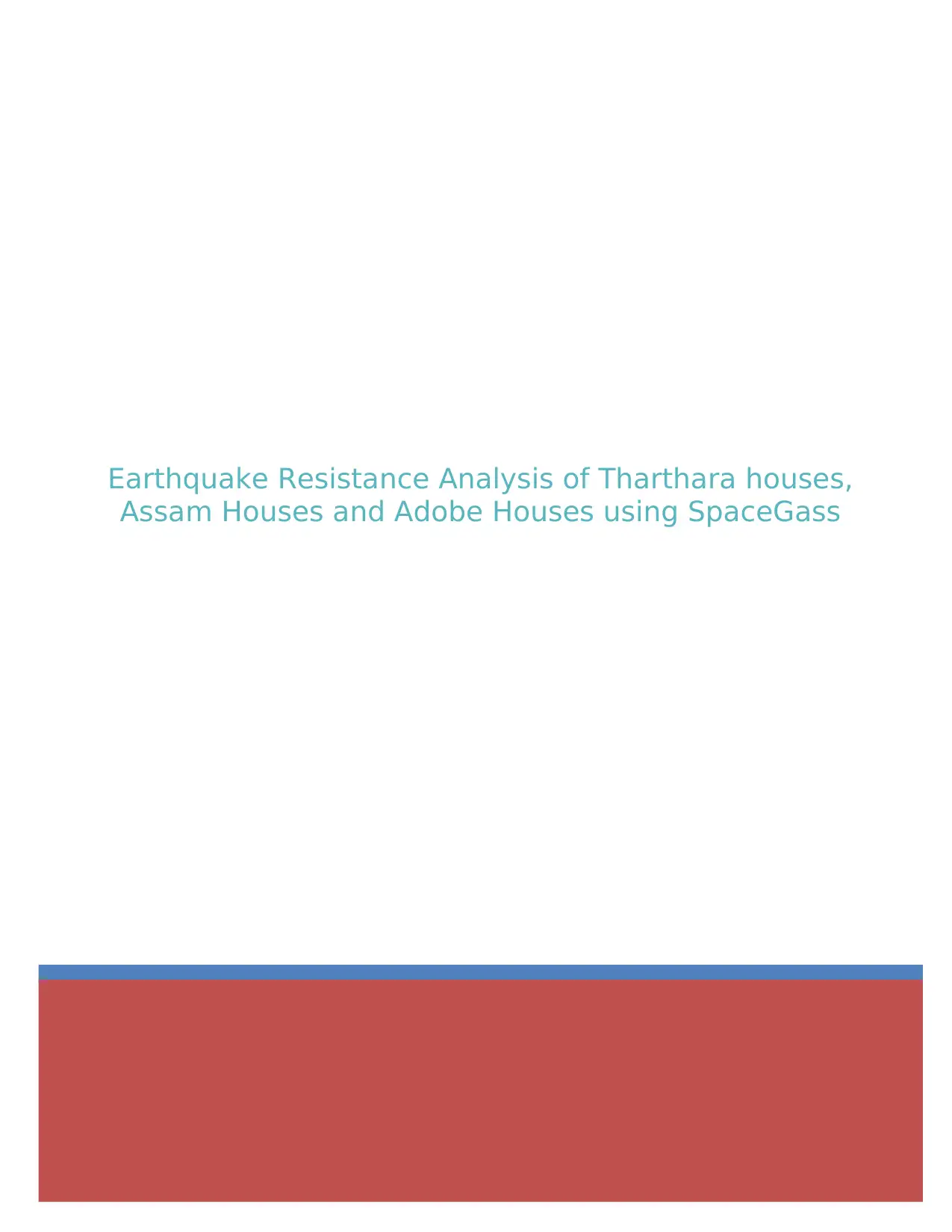
Earthquake Resistance Analysis of Tharthara houses,
Assam Houses and Adobe Houses using SpaceGass
Assam Houses and Adobe Houses using SpaceGass
Paraphrase This Document
Need a fresh take? Get an instant paraphrase of this document with our AI Paraphraser
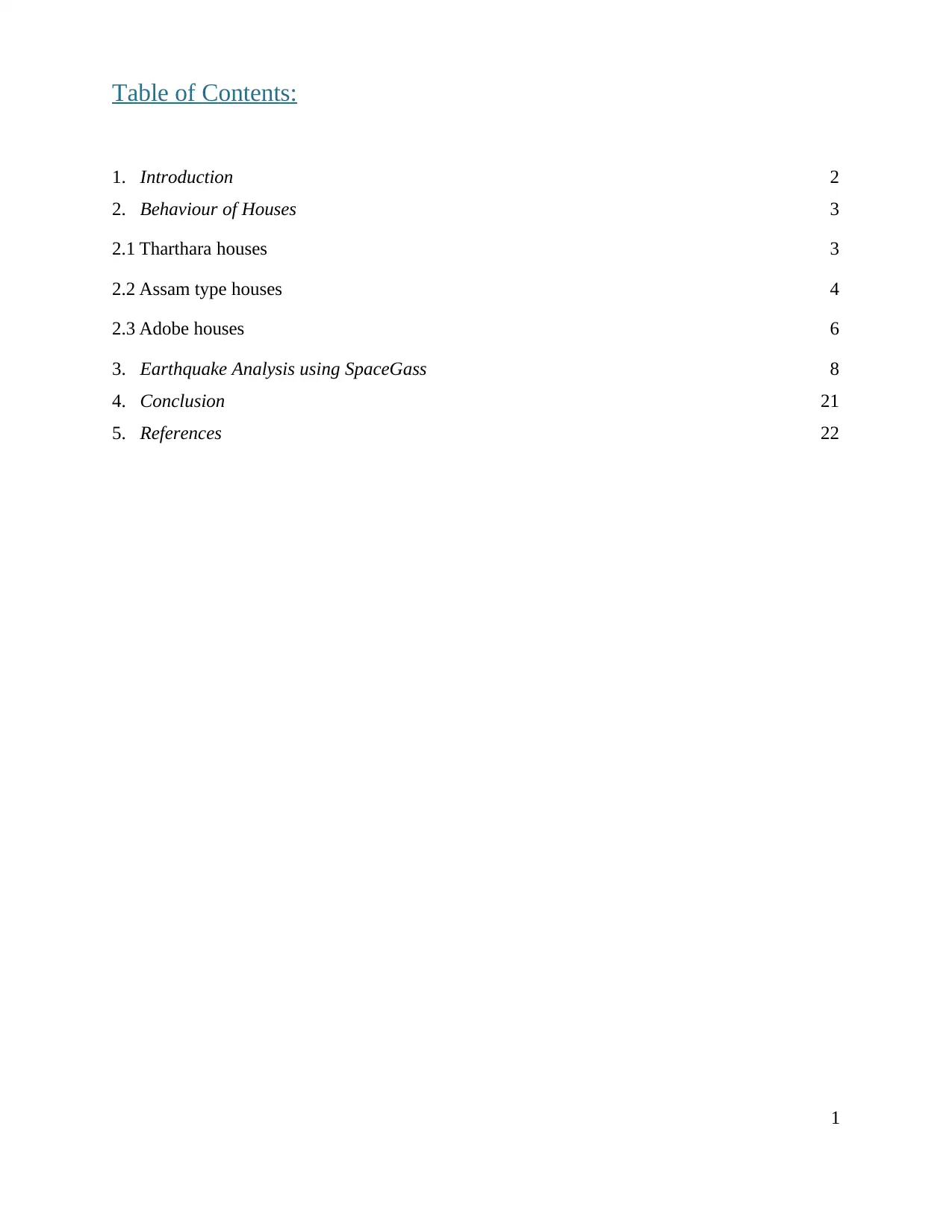
Table of Contents:
1. Introduction 2
2. Behaviour of Houses 3
2.1 Tharthara houses 3
2.2 Assam type houses 4
2.3 Adobe houses 6
3. Earthquake Analysis using SpaceGass 8
4. Conclusion 21
5. References 22
1
1. Introduction 2
2. Behaviour of Houses 3
2.1 Tharthara houses 3
2.2 Assam type houses 4
2.3 Adobe houses 6
3. Earthquake Analysis using SpaceGass 8
4. Conclusion 21
5. References 22
1

1. Introduction
Earthquakes are a leading natural phenomenon, which is capable of destroying properties, lives
and the entire economy. It occurs due to a sudden movement of one rock mass over another. The
contact surface where the slipping occurs is known as a ‘Fault’. The origin or place where the
earthquake commences is known as the ‘Hypocentre’ and the place directly on top of the
hypocentre at the earth’s surface is referred to us the ‘Epicentre’. (2015)
In building constructions, some structures are purposely designed to resist earthquakes.
However, it is important to note that such structures are not always strong enough to resist the
entire damage, but it can perform better during the earthquake as compared to other products. As
per building standards, such resistant structures are designed to withstand large calibre
earthquakes depending on their location. Hence, life loss should be minimal while functionality
loss should depend on frequency. (Citeseerx.ist.psu.edu, 2019)
For the development to be sustainable, the philosophy adopted at design should concentrate on
ensuring an increase in the efficient use of the available resources such as water, energy, and
materials; while decreasing the negative impact, a building can cause, to humans and the
environment at large. A balance in ecology must be maintained all the time to keep check on the
climate change hazards’. The use of concrete cement for construction purposes must be
discussed as its capacity to carry is considerably low.
Reverting to traditional methods is a sure way of realizing the dream of nature and humans
coexisting harmoniously. A reduction in building material locally added to the high cost of
construction points towards the question “What change should be made in the traditional
building standards and style to improve its viability in this modern time?” (World-housing.net,
2019)
2
Earthquakes are a leading natural phenomenon, which is capable of destroying properties, lives
and the entire economy. It occurs due to a sudden movement of one rock mass over another. The
contact surface where the slipping occurs is known as a ‘Fault’. The origin or place where the
earthquake commences is known as the ‘Hypocentre’ and the place directly on top of the
hypocentre at the earth’s surface is referred to us the ‘Epicentre’. (2015)
In building constructions, some structures are purposely designed to resist earthquakes.
However, it is important to note that such structures are not always strong enough to resist the
entire damage, but it can perform better during the earthquake as compared to other products. As
per building standards, such resistant structures are designed to withstand large calibre
earthquakes depending on their location. Hence, life loss should be minimal while functionality
loss should depend on frequency. (Citeseerx.ist.psu.edu, 2019)
For the development to be sustainable, the philosophy adopted at design should concentrate on
ensuring an increase in the efficient use of the available resources such as water, energy, and
materials; while decreasing the negative impact, a building can cause, to humans and the
environment at large. A balance in ecology must be maintained all the time to keep check on the
climate change hazards’. The use of concrete cement for construction purposes must be
discussed as its capacity to carry is considerably low.
Reverting to traditional methods is a sure way of realizing the dream of nature and humans
coexisting harmoniously. A reduction in building material locally added to the high cost of
construction points towards the question “What change should be made in the traditional
building standards and style to improve its viability in this modern time?” (World-housing.net,
2019)
2
⊘ This is a preview!⊘
Do you want full access?
Subscribe today to unlock all pages.

Trusted by 1+ million students worldwide
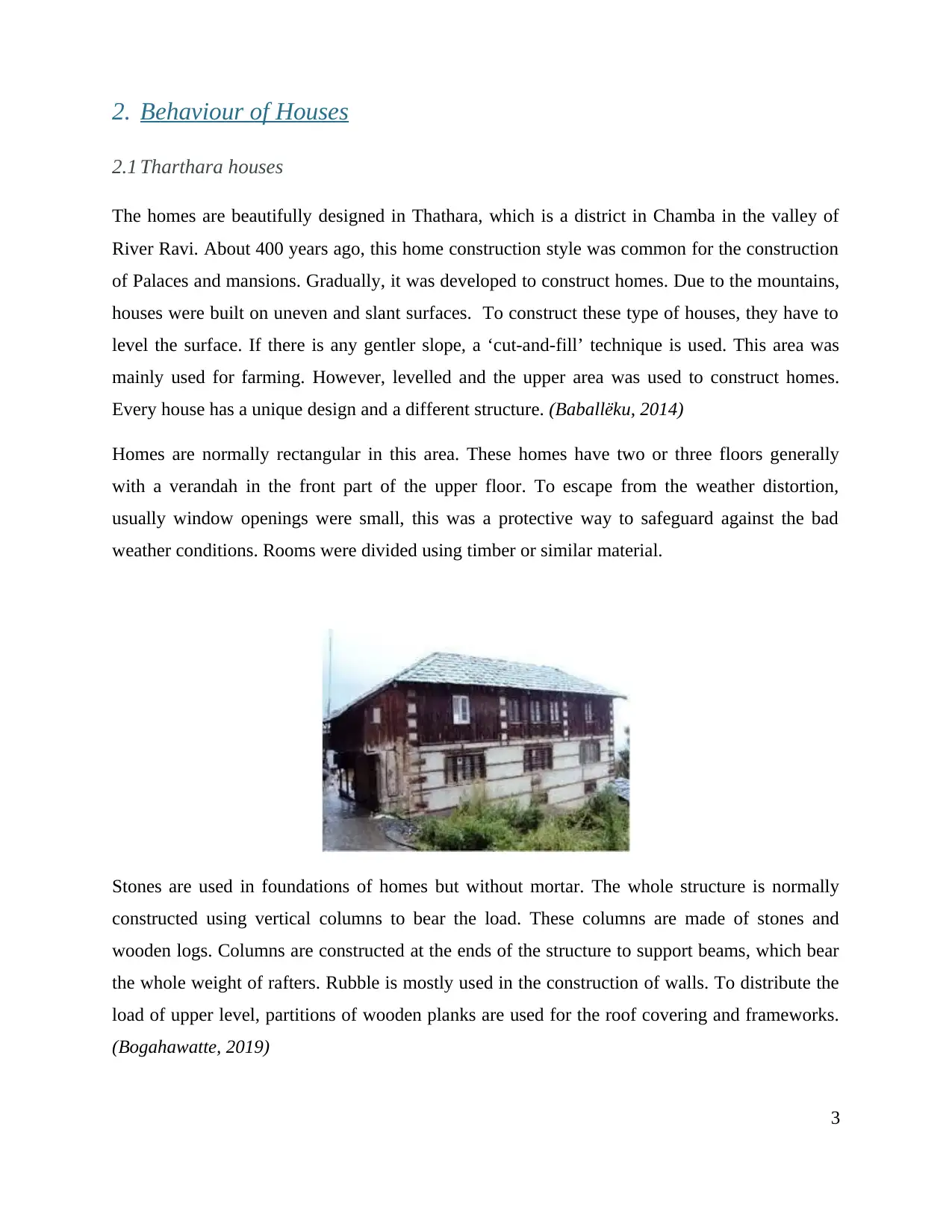
2. Behaviour of Houses
2.1 Tharthara houses
The homes are beautifully designed in Thathara, which is a district in Chamba in the valley of
River Ravi. About 400 years ago, this home construction style was common for the construction
of Palaces and mansions. Gradually, it was developed to construct homes. Due to the mountains,
houses were built on uneven and slant surfaces. To construct these type of houses, they have to
level the surface. If there is any gentler slope, a ‘cut-and-fill’ technique is used. This area was
mainly used for farming. However, levelled and the upper area was used to construct homes.
Every house has a unique design and a different structure. (Baballëku, 2014)
Homes are normally rectangular in this area. These homes have two or three floors generally
with a verandah in the front part of the upper floor. To escape from the weather distortion,
usually window openings were small, this was a protective way to safeguard against the bad
weather conditions. Rooms were divided using timber or similar material.
Stones are used in foundations of homes but without mortar. The whole structure is normally
constructed using vertical columns to bear the load. These columns are made of stones and
wooden logs. Columns are constructed at the ends of the structure to support beams, which bear
the whole weight of rafters. Rubble is mostly used in the construction of walls. To distribute the
load of upper level, partitions of wooden planks are used for the roof covering and frameworks.
(Bogahawatte, 2019)
3
2.1 Tharthara houses
The homes are beautifully designed in Thathara, which is a district in Chamba in the valley of
River Ravi. About 400 years ago, this home construction style was common for the construction
of Palaces and mansions. Gradually, it was developed to construct homes. Due to the mountains,
houses were built on uneven and slant surfaces. To construct these type of houses, they have to
level the surface. If there is any gentler slope, a ‘cut-and-fill’ technique is used. This area was
mainly used for farming. However, levelled and the upper area was used to construct homes.
Every house has a unique design and a different structure. (Baballëku, 2014)
Homes are normally rectangular in this area. These homes have two or three floors generally
with a verandah in the front part of the upper floor. To escape from the weather distortion,
usually window openings were small, this was a protective way to safeguard against the bad
weather conditions. Rooms were divided using timber or similar material.
Stones are used in foundations of homes but without mortar. The whole structure is normally
constructed using vertical columns to bear the load. These columns are made of stones and
wooden logs. Columns are constructed at the ends of the structure to support beams, which bear
the whole weight of rafters. Rubble is mostly used in the construction of walls. To distribute the
load of upper level, partitions of wooden planks are used for the roof covering and frameworks.
(Bogahawatte, 2019)
3
Paraphrase This Document
Need a fresh take? Get an instant paraphrase of this document with our AI Paraphraser
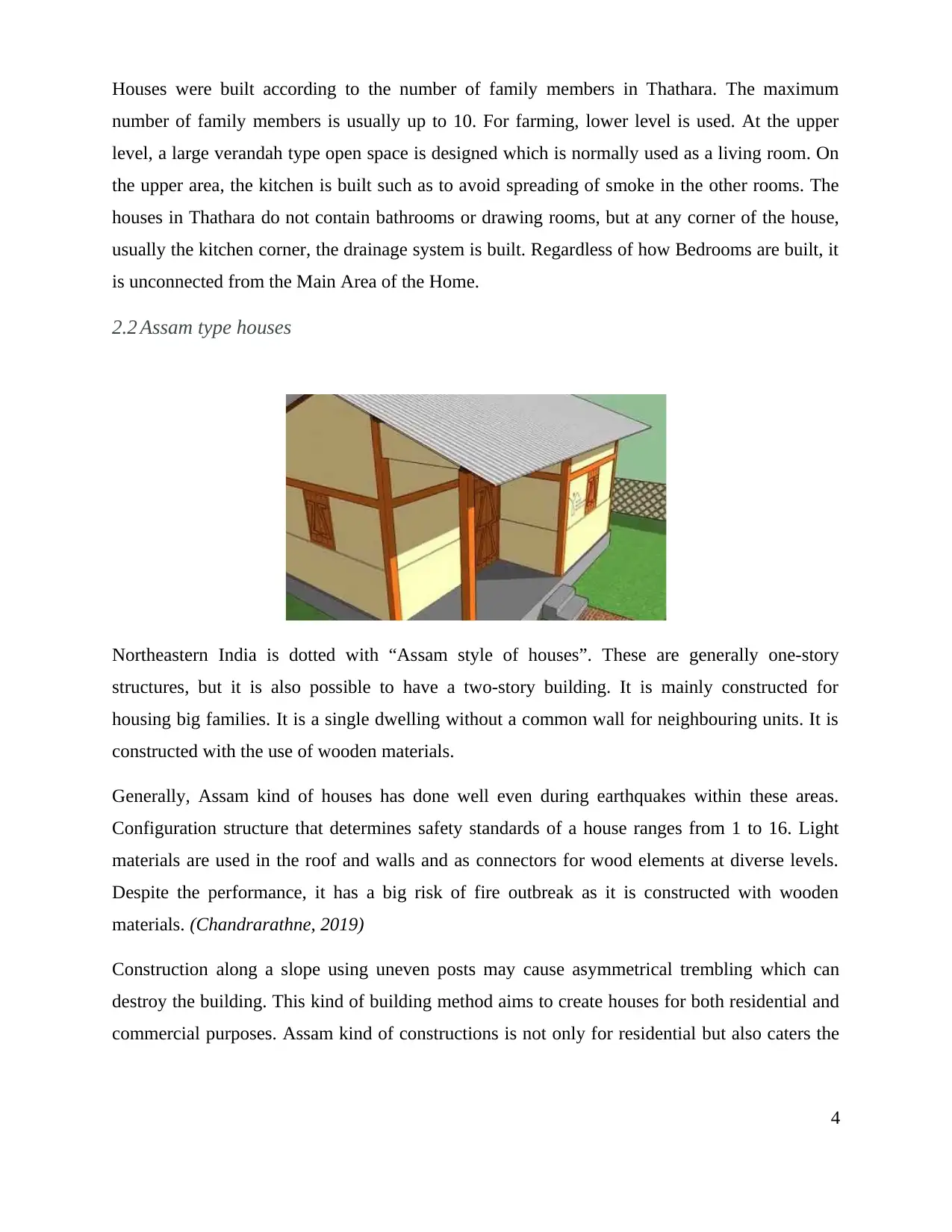
Houses were built according to the number of family members in Thathara. The maximum
number of family members is usually up to 10. For farming, lower level is used. At the upper
level, a large verandah type open space is designed which is normally used as a living room. On
the upper area, the kitchen is built such as to avoid spreading of smoke in the other rooms. The
houses in Thathara do not contain bathrooms or drawing rooms, but at any corner of the house,
usually the kitchen corner, the drainage system is built. Regardless of how Bedrooms are built, it
is unconnected from the Main Area of the Home.
2.2 Assam type houses
Northeastern India is dotted with “Assam style of houses”. These are generally one-story
structures, but it is also possible to have a two-story building. It is mainly constructed for
housing big families. It is a single dwelling without a common wall for neighbouring units. It is
constructed with the use of wooden materials.
Generally, Assam kind of houses has done well even during earthquakes within these areas.
Configuration structure that determines safety standards of a house ranges from 1 to 16. Light
materials are used in the roof and walls and as connectors for wood elements at diverse levels.
Despite the performance, it has a big risk of fire outbreak as it is constructed with wooden
materials. (Chandrarathne, 2019)
Construction along a slope using uneven posts may cause asymmetrical trembling which can
destroy the building. This kind of building method aims to create houses for both residential and
commercial purposes. Assam kind of constructions is not only for residential but also caters the
4
number of family members is usually up to 10. For farming, lower level is used. At the upper
level, a large verandah type open space is designed which is normally used as a living room. On
the upper area, the kitchen is built such as to avoid spreading of smoke in the other rooms. The
houses in Thathara do not contain bathrooms or drawing rooms, but at any corner of the house,
usually the kitchen corner, the drainage system is built. Regardless of how Bedrooms are built, it
is unconnected from the Main Area of the Home.
2.2 Assam type houses
Northeastern India is dotted with “Assam style of houses”. These are generally one-story
structures, but it is also possible to have a two-story building. It is mainly constructed for
housing big families. It is a single dwelling without a common wall for neighbouring units. It is
constructed with the use of wooden materials.
Generally, Assam kind of houses has done well even during earthquakes within these areas.
Configuration structure that determines safety standards of a house ranges from 1 to 16. Light
materials are used in the roof and walls and as connectors for wood elements at diverse levels.
Despite the performance, it has a big risk of fire outbreak as it is constructed with wooden
materials. (Chandrarathne, 2019)
Construction along a slope using uneven posts may cause asymmetrical trembling which can
destroy the building. This kind of building method aims to create houses for both residential and
commercial purposes. Assam kind of constructions is not only for residential but also caters the
4
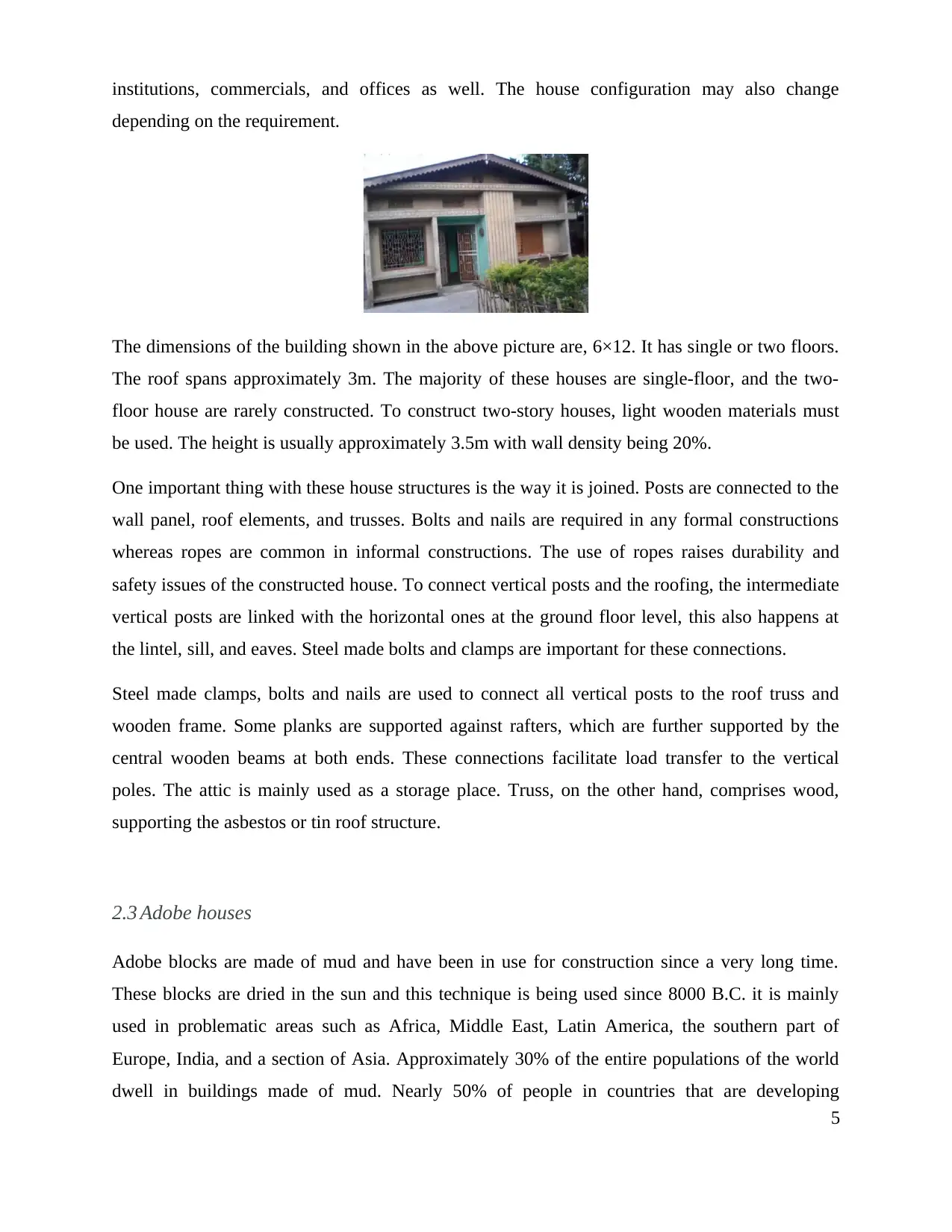
institutions, commercials, and offices as well. The house configuration may also change
depending on the requirement.
The dimensions of the building shown in the above picture are, 6×12. It has single or two floors.
The roof spans approximately 3m. The majority of these houses are single-floor, and the two-
floor house are rarely constructed. To construct two-story houses, light wooden materials must
be used. The height is usually approximately 3.5m with wall density being 20%.
One important thing with these house structures is the way it is joined. Posts are connected to the
wall panel, roof elements, and trusses. Bolts and nails are required in any formal constructions
whereas ropes are common in informal constructions. The use of ropes raises durability and
safety issues of the constructed house. To connect vertical posts and the roofing, the intermediate
vertical posts are linked with the horizontal ones at the ground floor level, this also happens at
the lintel, sill, and eaves. Steel made bolts and clamps are important for these connections.
Steel made clamps, bolts and nails are used to connect all vertical posts to the roof truss and
wooden frame. Some planks are supported against rafters, which are further supported by the
central wooden beams at both ends. These connections facilitate load transfer to the vertical
poles. The attic is mainly used as a storage place. Truss, on the other hand, comprises wood,
supporting the asbestos or tin roof structure.
2.3 Adobe houses
Adobe blocks are made of mud and have been in use for construction since a very long time.
These blocks are dried in the sun and this technique is being used since 8000 B.C. it is mainly
used in problematic areas such as Africa, Middle East, Latin America, the southern part of
Europe, India, and a section of Asia. Approximately 30% of the entire populations of the world
dwell in buildings made of mud. Nearly 50% of people in countries that are developing
5
depending on the requirement.
The dimensions of the building shown in the above picture are, 6×12. It has single or two floors.
The roof spans approximately 3m. The majority of these houses are single-floor, and the two-
floor house are rarely constructed. To construct two-story houses, light wooden materials must
be used. The height is usually approximately 3.5m with wall density being 20%.
One important thing with these house structures is the way it is joined. Posts are connected to the
wall panel, roof elements, and trusses. Bolts and nails are required in any formal constructions
whereas ropes are common in informal constructions. The use of ropes raises durability and
safety issues of the constructed house. To connect vertical posts and the roofing, the intermediate
vertical posts are linked with the horizontal ones at the ground floor level, this also happens at
the lintel, sill, and eaves. Steel made bolts and clamps are important for these connections.
Steel made clamps, bolts and nails are used to connect all vertical posts to the roof truss and
wooden frame. Some planks are supported against rafters, which are further supported by the
central wooden beams at both ends. These connections facilitate load transfer to the vertical
poles. The attic is mainly used as a storage place. Truss, on the other hand, comprises wood,
supporting the asbestos or tin roof structure.
2.3 Adobe houses
Adobe blocks are made of mud and have been in use for construction since a very long time.
These blocks are dried in the sun and this technique is being used since 8000 B.C. it is mainly
used in problematic areas such as Africa, Middle East, Latin America, the southern part of
Europe, India, and a section of Asia. Approximately 30% of the entire populations of the world
dwell in buildings made of mud. Nearly 50% of people in countries that are developing
5
⊘ This is a preview!⊘
Do you want full access?
Subscribe today to unlock all pages.

Trusted by 1+ million students worldwide
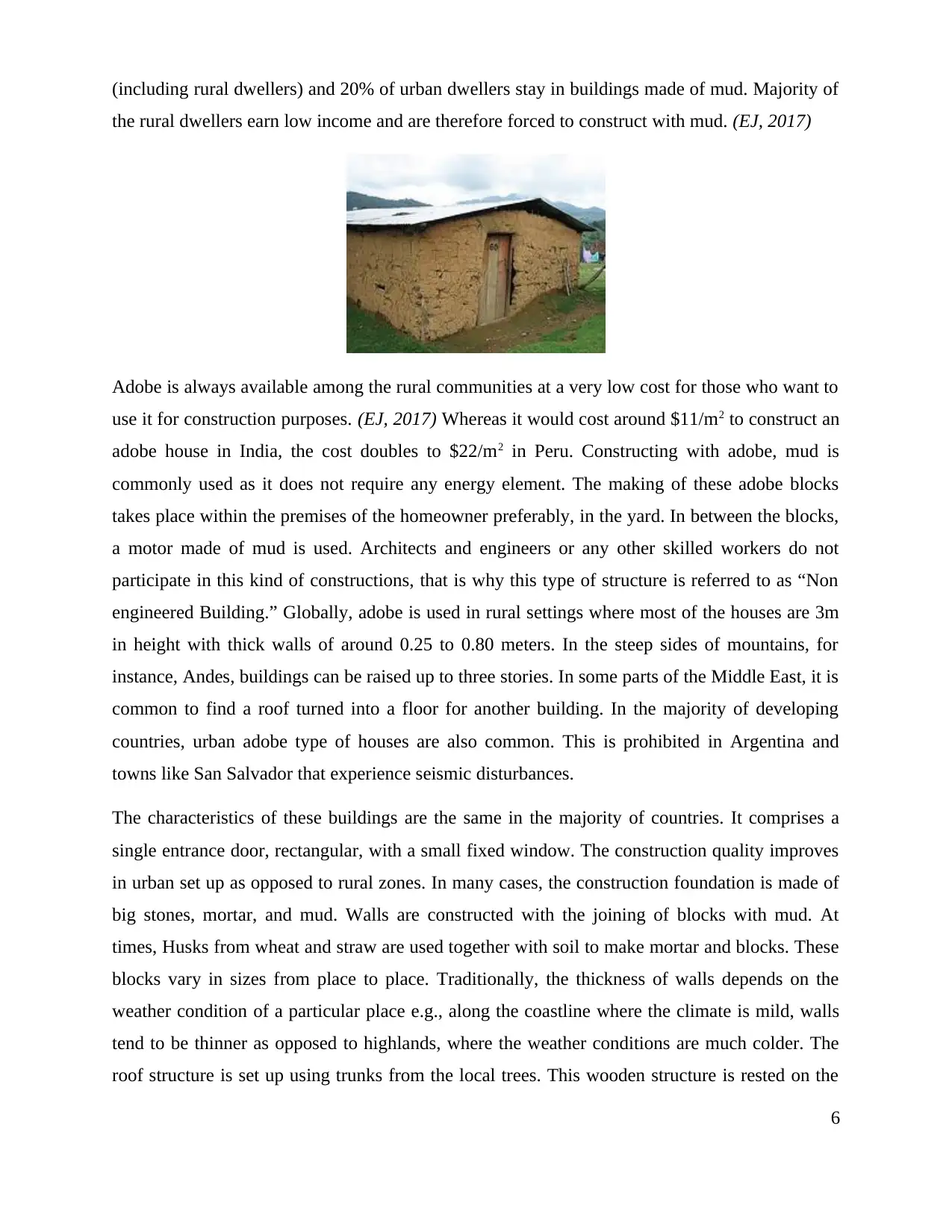
(including rural dwellers) and 20% of urban dwellers stay in buildings made of mud. Majority of
the rural dwellers earn low income and are therefore forced to construct with mud. (EJ, 2017)
Adobe is always available among the rural communities at a very low cost for those who want to
use it for construction purposes. (EJ, 2017) Whereas it would cost around $11/m2 to construct an
adobe house in India, the cost doubles to $22/m2 in Peru. Constructing with adobe, mud is
commonly used as it does not require any energy element. The making of these adobe blocks
takes place within the premises of the homeowner preferably, in the yard. In between the blocks,
a motor made of mud is used. Architects and engineers or any other skilled workers do not
participate in this kind of constructions, that is why this type of structure is referred to as “Non
engineered Building.” Globally, adobe is used in rural settings where most of the houses are 3m
in height with thick walls of around 0.25 to 0.80 meters. In the steep sides of mountains, for
instance, Andes, buildings can be raised up to three stories. In some parts of the Middle East, it is
common to find a roof turned into a floor for another building. In the majority of developing
countries, urban adobe type of houses are also common. This is prohibited in Argentina and
towns like San Salvador that experience seismic disturbances.
The characteristics of these buildings are the same in the majority of countries. It comprises a
single entrance door, rectangular, with a small fixed window. The construction quality improves
in urban set up as opposed to rural zones. In many cases, the construction foundation is made of
big stones, mortar, and mud. Walls are constructed with the joining of blocks with mud. At
times, Husks from wheat and straw are used together with soil to make mortar and blocks. These
blocks vary in sizes from place to place. Traditionally, the thickness of walls depends on the
weather condition of a particular place e.g., along the coastline where the climate is mild, walls
tend to be thinner as opposed to highlands, where the weather conditions are much colder. The
roof structure is set up using trunks from the local trees. This wooden structure is rested on the
6
the rural dwellers earn low income and are therefore forced to construct with mud. (EJ, 2017)
Adobe is always available among the rural communities at a very low cost for those who want to
use it for construction purposes. (EJ, 2017) Whereas it would cost around $11/m2 to construct an
adobe house in India, the cost doubles to $22/m2 in Peru. Constructing with adobe, mud is
commonly used as it does not require any energy element. The making of these adobe blocks
takes place within the premises of the homeowner preferably, in the yard. In between the blocks,
a motor made of mud is used. Architects and engineers or any other skilled workers do not
participate in this kind of constructions, that is why this type of structure is referred to as “Non
engineered Building.” Globally, adobe is used in rural settings where most of the houses are 3m
in height with thick walls of around 0.25 to 0.80 meters. In the steep sides of mountains, for
instance, Andes, buildings can be raised up to three stories. In some parts of the Middle East, it is
common to find a roof turned into a floor for another building. In the majority of developing
countries, urban adobe type of houses are also common. This is prohibited in Argentina and
towns like San Salvador that experience seismic disturbances.
The characteristics of these buildings are the same in the majority of countries. It comprises a
single entrance door, rectangular, with a small fixed window. The construction quality improves
in urban set up as opposed to rural zones. In many cases, the construction foundation is made of
big stones, mortar, and mud. Walls are constructed with the joining of blocks with mud. At
times, Husks from wheat and straw are used together with soil to make mortar and blocks. These
blocks vary in sizes from place to place. Traditionally, the thickness of walls depends on the
weather condition of a particular place e.g., along the coastline where the climate is mild, walls
tend to be thinner as opposed to highlands, where the weather conditions are much colder. The
roof structure is set up using trunks from the local trees. This wooden structure is rested on the
6
Paraphrase This Document
Need a fresh take? Get an instant paraphrase of this document with our AI Paraphraser

wall for the support. Majority of the roofs are made of zinc corrugated sheets or tiles made of
clay. This depends on the owners' economic conditions and culture of the community around that
particular region.
7
clay. This depends on the owners' economic conditions and culture of the community around that
particular region.
7
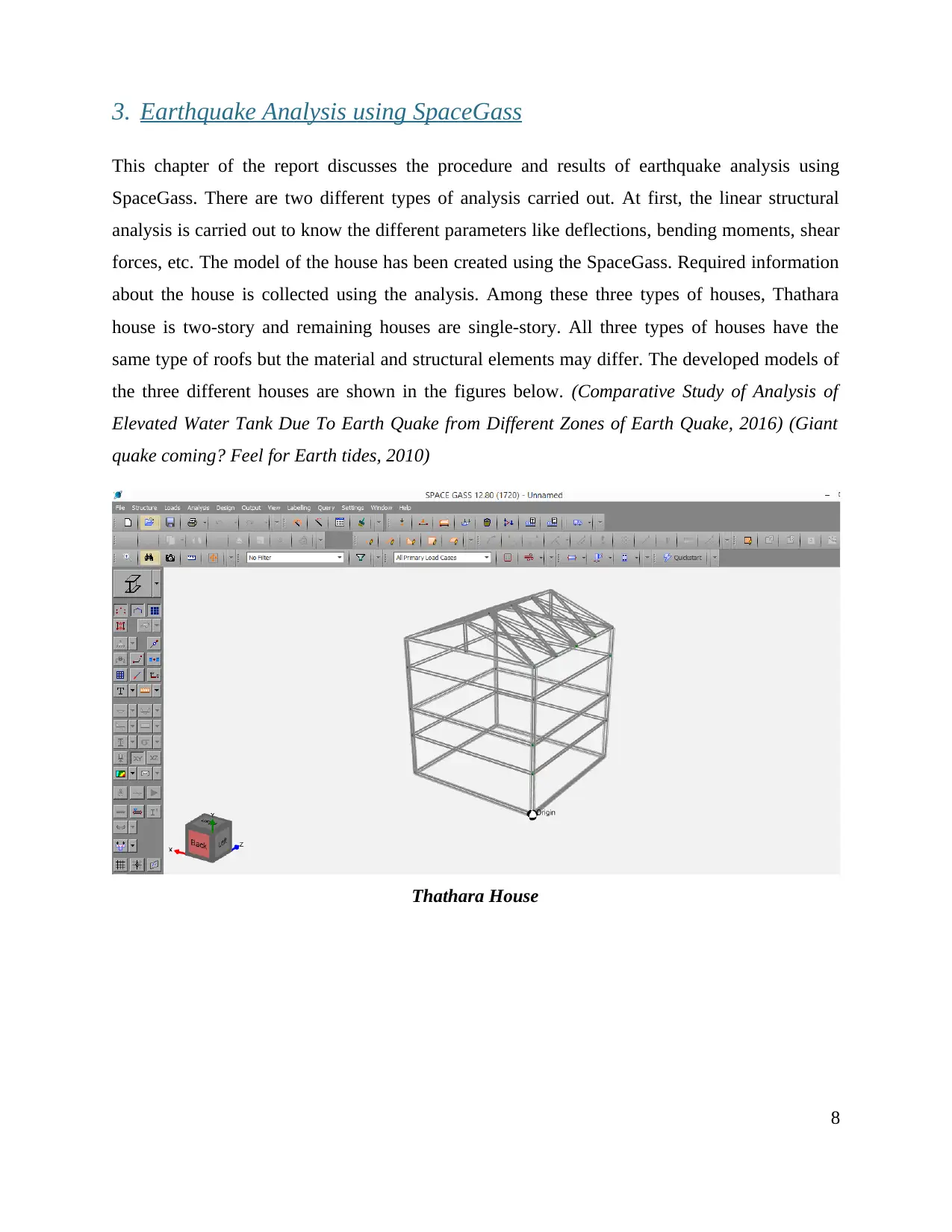
3. Earthquake Analysis using SpaceGass
This chapter of the report discusses the procedure and results of earthquake analysis using
SpaceGass. There are two different types of analysis carried out. At first, the linear structural
analysis is carried out to know the different parameters like deflections, bending moments, shear
forces, etc. The model of the house has been created using the SpaceGass. Required information
about the house is collected using the analysis. Among these three types of houses, Thathara
house is two-story and remaining houses are single-story. All three types of houses have the
same type of roofs but the material and structural elements may differ. The developed models of
the three different houses are shown in the figures below. (Comparative Study of Analysis of
Elevated Water Tank Due To Earth Quake from Different Zones of Earth Quake, 2016) (Giant
quake coming? Feel for Earth tides, 2010)
Thathara House
8
This chapter of the report discusses the procedure and results of earthquake analysis using
SpaceGass. There are two different types of analysis carried out. At first, the linear structural
analysis is carried out to know the different parameters like deflections, bending moments, shear
forces, etc. The model of the house has been created using the SpaceGass. Required information
about the house is collected using the analysis. Among these three types of houses, Thathara
house is two-story and remaining houses are single-story. All three types of houses have the
same type of roofs but the material and structural elements may differ. The developed models of
the three different houses are shown in the figures below. (Comparative Study of Analysis of
Elevated Water Tank Due To Earth Quake from Different Zones of Earth Quake, 2016) (Giant
quake coming? Feel for Earth tides, 2010)
Thathara House
8
⊘ This is a preview!⊘
Do you want full access?
Subscribe today to unlock all pages.

Trusted by 1+ million students worldwide
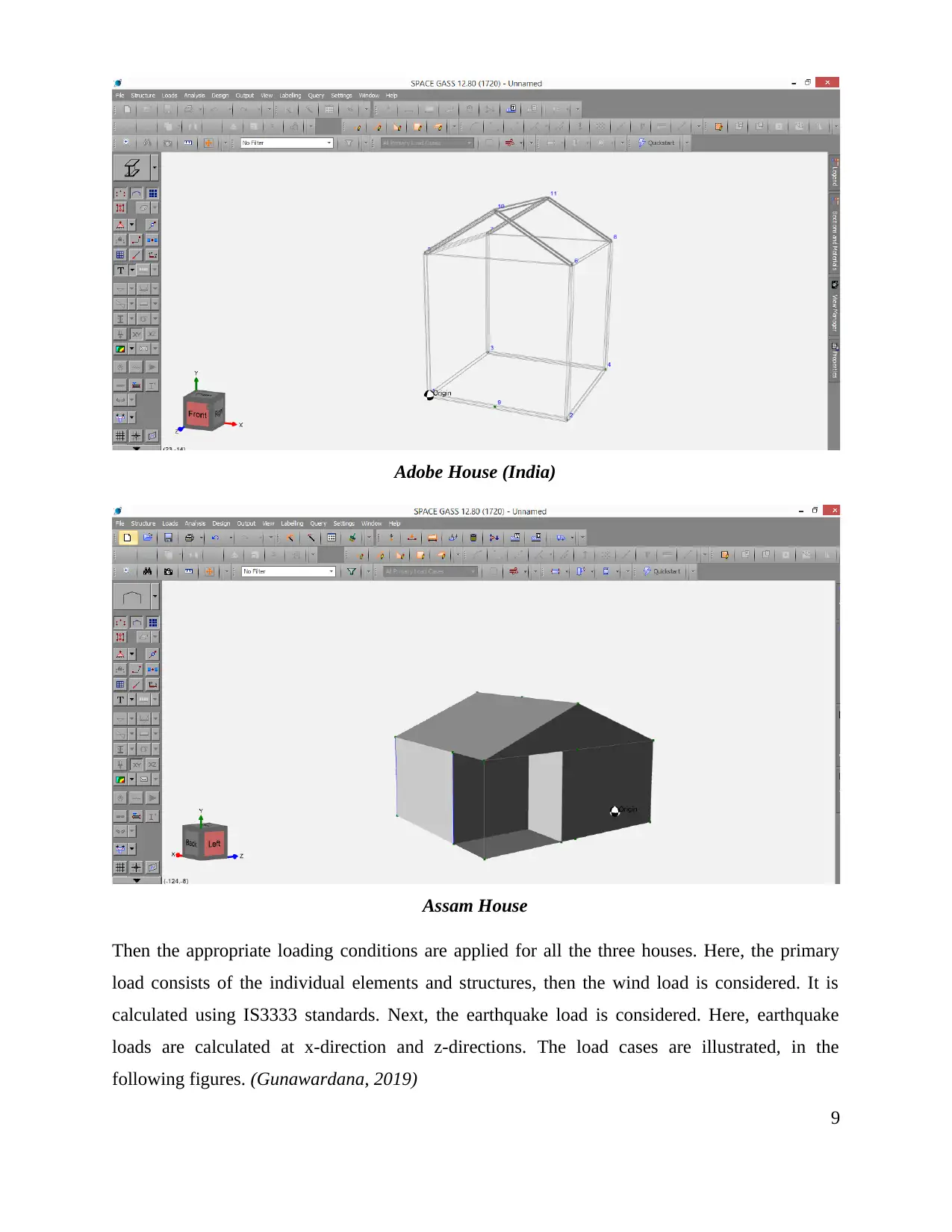
Adobe House (India)
Assam House
Then the appropriate loading conditions are applied for all the three houses. Here, the primary
load consists of the individual elements and structures, then the wind load is considered. It is
calculated using IS3333 standards. Next, the earthquake load is considered. Here, earthquake
loads are calculated at x-direction and z-directions. The load cases are illustrated, in the
following figures. (Gunawardana, 2019)
9
Assam House
Then the appropriate loading conditions are applied for all the three houses. Here, the primary
load consists of the individual elements and structures, then the wind load is considered. It is
calculated using IS3333 standards. Next, the earthquake load is considered. Here, earthquake
loads are calculated at x-direction and z-directions. The load cases are illustrated, in the
following figures. (Gunawardana, 2019)
9
Paraphrase This Document
Need a fresh take? Get an instant paraphrase of this document with our AI Paraphraser
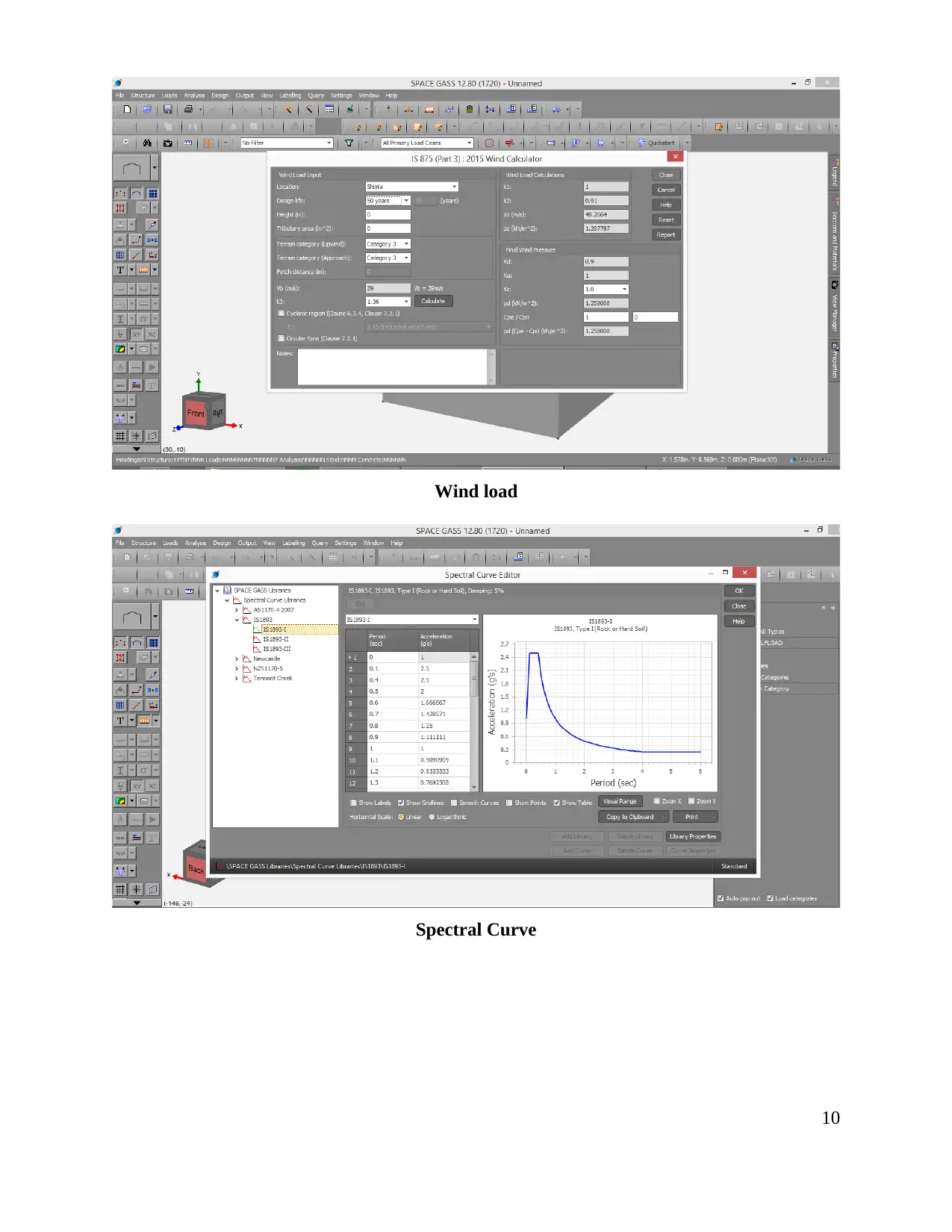
Wind load
Spectral Curve
10
Spectral Curve
10
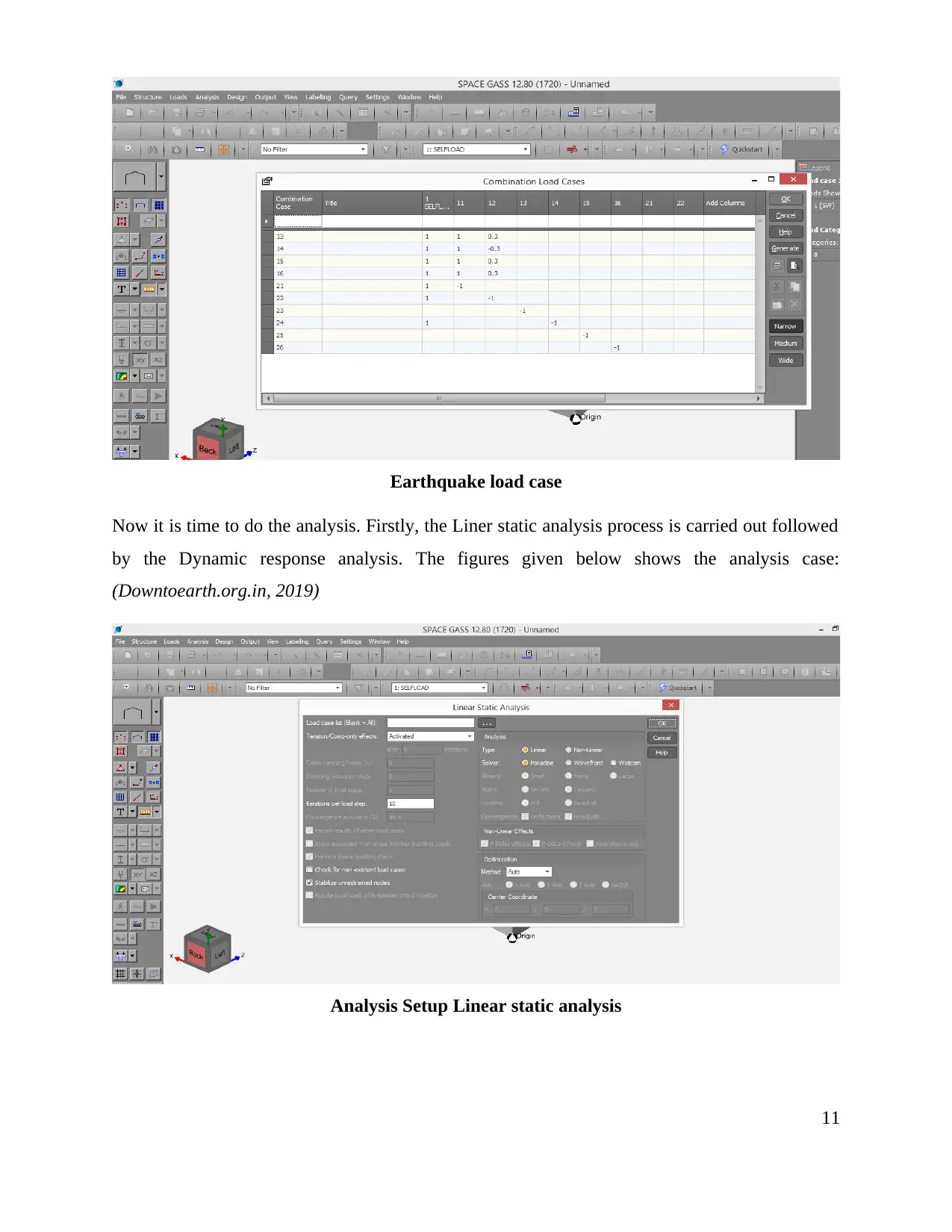
Earthquake load case
Now it is time to do the analysis. Firstly, the Liner static analysis process is carried out followed
by the Dynamic response analysis. The figures given below shows the analysis case:
(Downtoearth.org.in, 2019)
Analysis Setup Linear static analysis
11
Now it is time to do the analysis. Firstly, the Liner static analysis process is carried out followed
by the Dynamic response analysis. The figures given below shows the analysis case:
(Downtoearth.org.in, 2019)
Analysis Setup Linear static analysis
11
⊘ This is a preview!⊘
Do you want full access?
Subscribe today to unlock all pages.

Trusted by 1+ million students worldwide
1 out of 25
Related Documents
Your All-in-One AI-Powered Toolkit for Academic Success.
+13062052269
info@desklib.com
Available 24*7 on WhatsApp / Email
![[object Object]](/_next/static/media/star-bottom.7253800d.svg)
Unlock your academic potential
Copyright © 2020–2025 A2Z Services. All Rights Reserved. Developed and managed by ZUCOL.





